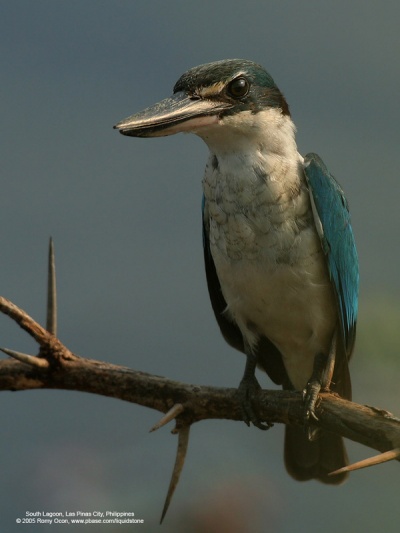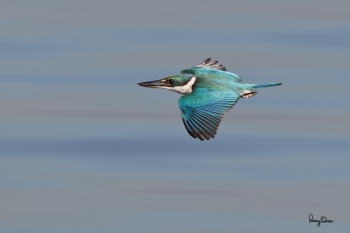- Todiramphus chloris
Halcyon chloris
Identification
22-29 cm
- Blue-green upperparts
- White or buff underparts
- White neck collar
- Black eye stripe
- Black bill
- Pale yellow lower mandible
Female: more green
Subspecies vary with white or buff eyestripes, white spot between bill and eye.
Distribution
Locally around the Red Sea, the Arabian Peninsula, India to southeast Asia, Indonesia and the Philippines. Southern Asia and Malaysia.
Taxonomy
Was previously Halcyon chloris. The Sibley-Monroe spelling of the scientific name (Todirhamphus chloris) is incorrect. Clements and Howard & Moore both use Todiramphus chloris. More details in this discussion.
This is a polytypic species formerly consisting of 50+ subspecies which are now split into six species: Collared Kingfisher, Pacific Kingfisher, Torresian Kingfisher, Mariana Kingfisher, Melanesian Kingfisher and Colonist Kingfisher.
Subspecies
14 subspecies recognized:
- T. c. abyssinicus: West coast of Red Sea to head of Gulf of Aden
- T. c. kalbaensis: South coast of Arabian Peninsula to extreme north-western Oman
- T. c. humii: coasts from northeastern India (West Bengal) and Bangladesh east to Myanmar, Thailand, Malay Peninsula (including Tioman Island and the Mergui Archipelago), and northeastern Sumatra
- T. c. vidali: Peninsular India (Ratnagiri District)
- T. c. armstrongi: interior of Myanmar and Thailand to Cambodia, southern Laos, and Vietnam
- T. c. davisoni: Andaman Islands and Cocos Islands (Indian Ocean)
- T. c. occipitalis: Nicobar Islands
- T. c. chloropterus: Islands off western Sumatra (except Enggano)
- T. c. azelus: Enggano Island (off south-western [Sumatra]])
- T. c. palmeri: Java, Bali and adjacent islands in Java Sea
- T. c. laubmannianus: Southern Sumatra, Borneo and adjacent islands
- T. c. collaris: Philippines, Sulu Archipelago and Palawan
- T. c. chloris: Sulawesi to north-western New Guinea and Lesser Sundas
- T. c. teraokai: Palau Islands (western Caroline Islands)
Habitat
Coastal areas, mangrove swamps, farmland, open woodland, grassland and gardens.
Behaviour
Diet
The diet includes crabs, insects, shrimps, frogs, worms, snails, lizards and small fish.
Breeding
It nests in holes. The clutch consists of 2-7 round whitish eggs which are incubated by both parents. The young fledge about 44 days after hatching.
References
- Clements, J. F., T. S. Schulenberg, M. J. Iliff, D. Roberson, T. A. Fredericks, B. L. Sullivan, and C. L. Wood. 2015. The eBird/Clements checklist of birds of the world: v2015, with updates to August 2015. Downloaded from http://www.birds.cornell.edu/clementschecklist/download/
- Gill, F and D Donsker (Eds). 2015. IOC World Bird Names (version 5.4). Available at http://www.worldbirdnames.org/.
- Handbook of the Birds of the World Alive (retrieved October 2015)
Recommended Citation
- BirdForum Opus contributors. (2025) Collared Kingfisher. In: BirdForum, the forum for wild birds and birding. Retrieved 17 May 2025 from https://www.birdforum.net/opus/Collared_Kingfisher
External Links
GSearch checked for 2020 platform.1







